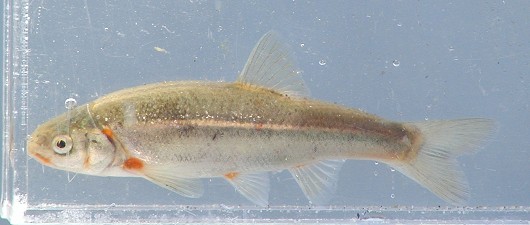Clear Lake Roach
-
Scientific NameLavinia symmetricus subspecies
-
NativeYes
-
Identification
 California roach. Captured from the Gualala River. Photo by Carl Page, ARS Consulting.
California roach. Captured from the Gualala River. Photo by Carl Page, ARS Consulting.PLEASE NOTE: The photos and information shown here are for the species California Roach (Lavinia symmetricus), of which the Clear Lake Roach is a sub-species.
- Small chunky fish, usually less than 100 mm TL, rarely exceed 120 mm SL
- Large head, small downward turned mouth
- Coloration: body is usually gray to blue on top, silvery underside
- Spawning adults: may develop orange and red colorations on chin and paired fins
- Breeding males may develop series of nodes or tubercles on head
- Fin rays: dorsal 7-9, anal 6-8
- Lateral line scales: 47-63
-
Life History
California Roach are capable of adapting to varying habitats from coastal streams to mountain foothill streams. They are predominately found in small warm streams but are capable of thriving in larger colder streams with diverse conditions. They may actually occupy several different habitat types within a single drainage. Extreme tolerance includes temperatures ranging from 30-35ºC and dissolved oxygen levels as low as 1-2 ppm. In-stream location may vary depending on geography and predators. When California Roach share water with Sacramento Pikeminnows, Roach will stick to the stream margins, whereas in the absence of these piscivorous fish Roach may venture into deeper pools. California Roach are omnivorous and diet may depend on stream size and food availability. In smaller rivers Roach feed mostly on filamentous algae, supplementing their diet with crustaceans and insects. In larger rivers these fish may focus on a diet of aquatic insects year round. The growth and development of California Roach is largely seasonally dependent. Most growth occurs during the summer months and Roach may grow 20-40 mm in a year. Most fish of this species reach sexual maturity at age 2-3 and rarely live beyond three years total. Spawning occurs in March through early July, and timing is temperature dependent. California Roach breed in gravel beds or riffles where groups of females lay eggs on and into the substrate. One or two males follow each female closely to fertilize the groups of eggs. Each female may produce 250-2,000 eggs per year depending on body size. The eggs hatch in 2-3 days, but the larvae remain in the protection of the gravel substrate before emerging to swim.
-
Links to Other Research
Thompson, L.C., G.A. Giusti, K. Weber, R.F. Keiffer. 2013. The native and introduced fishes of Clear Lake: A review of the past to assist with decisions of the future. California Fish and Game 99(1):7-41. Download
Weber, Kristina L., Lisa C. Thompson, Gregory A. Giusti, and Ryan F. Keiffer. 2011. Clear Lake Annotated Bibliography. University of California Cooperative Extension. 226 p. (302 references) Download
This bibliography contains 302 references, including journal articles, books, reports, newspaper articles, and videos. The main focus was on fish, particularly Clear Lake hitch and largemouth bass, but there are also references on culture, settlement, mining, and lake water chemistry. Items are listed in alphabetical order by author, beginning with anonymous works (no author listed).
